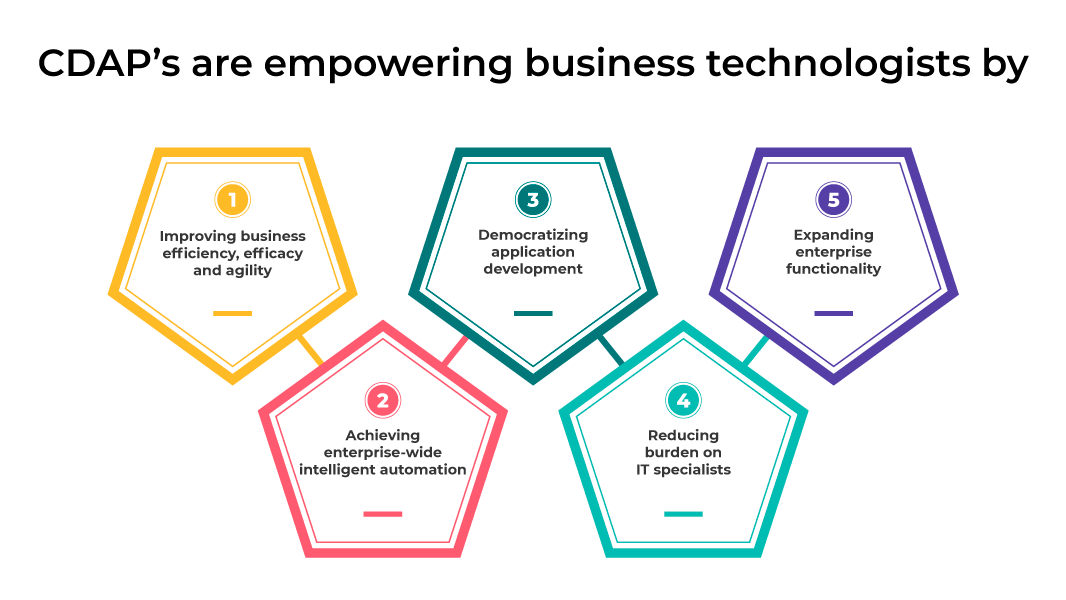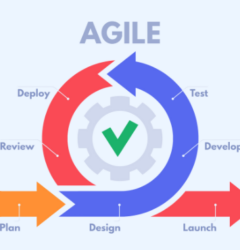09 Aug

In the past few years, no-code development tools have democratized application development in organizations by enabling non-technical employees to be creative with technology. Gartner surveyed 12,000 employees across different functions and industries, and 41% of respondents preferred to be called “business technologists.”
So who exactly is a business technologist?
A business technologist is an employee who reports outside of IT departments and creates technology or analytics capabilities for internal or external business use. As per Gartner’s report, business technologists make up between 28% and 55% of the workforce, depending on the industry.
The majority of them are citizen technologists (non-coders who build business-specific applications using no-code platforms) and some of them are dedicated technologists (who are software engineers/data scientists/coders but are a part of non-technical teams such as marketing and R&D). Therefore, it’s wrong to say that all business technologists are citizen developers.
Most business technologists do not only create new technology; they also maintain it. As per Gartner’s survey, 79% of business technologists were personally active in maintaining the application in addition to developing it, and 28% were involved in activities spanning the entire capability life cycle.
Listen to this episode, where ThinkCast host Kasey Panetta is joined by Jaime Capella, Distinguished VP, to shed light on business technologist and the democratization of digital delivery.
Examples of a business technologist’s persona
1. For dedicated technologists
- A PHP developer being a part of the marketing team.
- A data scientist being a part of financial planning and analysis.
- A software engineer being a part of R&D
2. Citizen technologist
- A pricing manager who builds algorithms
- A customer representative who builds chatbots
- A physician who builds pandemic apps
What do business technologists work on?
Business technologists create a broad range of mission-critical technology capabilities, including analytics, digital commerce platforms, artificial intelligence, and robotic process automation. This range reflects the fact that business technologists operate in a variety of different areas throughout the organization. While most business technologists develop capabilities for their own departments, there are some who develop and maintain capabilities for external groups or divisions – for other departments and external users. As per Gartner, 41% of employees can be called business technologists but this number varies significantly by industry. For example, the number is close to 50% for the IT-based industry while it is near 25% for the non-IT-intensive sectors like government, etc.
The following are the work areas for business technologists:
- Integrating data flows
- Designing analytical models
- Creating algorithms
- Training algorithms
- Building or customizing user interfaces
- Creating new software functionalities
- Combining existing software functionalities
Check out this very insightful podcast episode where Dixie John talks to Jason Wong, a distinguished analyst from Gartner, about Business Technologist and Fusion Teams, the contributing factors in democratizing app development.
How citizen development and automation platforms (CDAP) are empowering business technologists?
CDAPs enable business technologists to build a variety of capabilities. Adoption of CDAPs helps business technologists with the following use cases:
- Building web and mobile forms for employees, partners, or customers.
- Automating personal and departmental workflows.
- Connecting data and content across SaaS applications.
- Creating reports and data visualizations within the platform to aid productivity.
By leveraging CDAPs, organizations can empower both business technologists and IT engineers by:

1. Improving business efficiency, efficacy, and agility
CDAPs enable citizen technologists to create, automate, and integrate processes without employing IT directly, resulting in increased organizational efficiency, effectiveness, and agility. Users can autonomously build solutions to address individual, team, or departmental challenges by leveraging intuitive no-code and low-code tools. This way, the organization can achieve business-driven hyper-automation at a rather quick pace.
2. Achieving enterprise-wide intelligent automation
Automating workflows and alleviating the pains of paper-based processes are key objectives of no-code development. With CDAPs, business technologists can build intelligent automation applications for their most critical priorities. This way, the entire organization can collaboratively move towards a paperless environment without relying on either low-code or traditional coding.
One of the best examples of a no-code automation solution is Intelligent Document Processing (IDP), which can turn unstructured and semi-structured information into usable data. It is a next-generation solution that uses natural language processing to categorize, extract, and validate relevant information from a variety of unstructured sources (PDF documents, emails, images, etc). There are other cutting-edge no-code solutions that can hyperautomate help desk support, CRM, travel & expense management, loan management, and organizational training management, to name a few.
3. Democratizing application development
People are becoming more technologically savvy in the workplace, and many of the newer employees (business executives, HRs, marketing, and sales personnel) want to develop their own applications. As per a survey by Gartner, 73% of business executives had higher technology goals than they had previously. CDAPs give business technologists the freedom to build bespoke applications, with minimum interference from software engineering leaders. This freedom is what makes business technologists more productive.
Also Read: Four Key Drivers Impacting The Democratization Of Automation
4. Reducing the burden on IT specialists
By fostering autonomy inside business units, organizations may alleviate some of the workloads that would otherwise fall on their IT engineers, allowing them to focus on strategic projects that are more aligned with their skills.
5. Expanding enterprise functionality
Digital transformation is not only about an organization’s ability to repackage its existing services, competencies, and processes into digital assets. It is also about expanding the enterprise’s functionalities by integrating no-code, low-code, or hand-coded applications with valuable third-party solutions.
CDAPs can enable business technologists to seamlessly integrate modern systems with legacy technologies and enable easy configuration of APIs using plug-in components. They can graphically represent all key software components—including third-party integrations — in a visual UI where they can be configured with ease.
These third-party integrations can enable enterprises to:
- Not miss out on vital solutions in the market
- Enhance operational efficiency
- Derive the best out of legacy systems
Business technologists can manage enterprise risks
Contrary to conventional wisdom, a majority of business technologists take the responsibility of building secure, reusable, and compliant applications, rather than putting the entire onus on IT departments.
Interestingly, there is a correlation between business technologists’ age/professional experience and their tendency to own risks. For example, Gen X business technologists are more likely to take responsibility for enterprise risks than their younger counterparts. Moreover, business technologists in heavily regulated industries such as finance and healthcare are more likely to take the onus of mitigating enterprise risks, when compared to those who work in less regulated industries and sectors.

Fusion teams improve the efficiency of business technologists
It’s essential to learn about team structures that can bring the best out of business technologists. Usually, business technologists prefer to work in multidisciplinary teams where team members come from different business areas or technical backgrounds, and very few have no experience of working in a team setting. They like to work both collaboratively and iteratively to deliver value on a continuous basis.
The right team structure can have a positive impact on these three traits of business technologists:
- Technical dexterity: The ability to apply technical skills independently and use no-code or low-code at an advanced level.
- Risk ownership: The ability to take responsibility for architectural and security outcomes.
- Business acumen: The ability to understand the existing scenario and anticipate the future business needs, to build bespoke applications.
Among different team structures, multidisciplinary fusion teams enhance the above-mentioned traits in business technologists. As per the Gartner’ survey, business technologists are 1.9 times more likely to attain high levels of technical dexterity, 3.3 times more likely to assume enterprise risk ownership, and 1.6 times more likely to successfully achieve their outcomes when they are a part of fusion teams instead of working independently.
Do business technologists circumvent IT?
CEOs and CIOs often bring up “shadow IT” when arguing against business technologists. They argue that no-code platforms allow business technologists or at least give them an opportunity to independently build applications without any intervention from IT – and there is a risk associated with it. What’s the risk?
- They may end up building half-baked applications and the IT team may not be aware of it. Such incompetent applications may float across different departments and hamper the organization’s innovation goals.
- Business technologists can form a “secret society of application development.”
But this danger of shadow IT can be tackled with a well-established IT governance model that can make business technologists more accountable and won’t allow them to circumvent IT. They can have the freedom to leverage no-code platforms, but at the same time, their roles, responsibilities, and permissions can be defined.
That being said, business technologists mostly find it fruitful to collaborate with IT, as they can then build capabilities that are far more innovative, scalable, reliable, secure, and maintainable, which is not the case when business technologies function independently. Moreover, with the support of IT, applications can be built in a quick span of time.
Also read: The Yoda way to knock IT backlogs out of the park!
Top leadership’s perception of business technologists
As the demand for technological innovation is surging, small IT teams at mid-size enterprises are finding it difficult to keep up. Having business technologists in their workforce is a promising way to address the digital demands of the business. But CxOs at mid-size enterprises have mixed opinions regarding this.
Some of them are of the opinion that business technologists bring nothing but benefits, while there are some who feel that business technologists pose a few risks as well. Then there are those who have a balanced viewpoint and are convinced that business technologists bring both benefits and risks to the table.
Top leaders see capacity and not efficiency as the benefit
The vast majority of CxOs believe that business technologists equip enterprises with the required capability to accelerate digitally. As per them, there is more to citizen development than transferring work from IT to business teams.
- Top leaders believe business technologists give their firms the necessary capacity for digital initiatives.
- They believe business technologists help improve their enterprises’ operations.
- They believe business technologists reduce the need for IT to hire new employees.
Based on these beliefs, business technologists (both dedicated technologists and citizen developers) are being given responsibilities to oversee process automation and customer experience initiatives, whereas IT engineers are focused on building platforms and enterprise-grade systems. In fact, in many organizations, there is a strong sense that business technologists can create more demand for IT support and innovation, not less.
Business technologists introduce both benefits and risks
Overall, CIOs of midsize companies have mixed opinions on business technologists, as most of them feel there are both benefits and risks involved in having a workforce that works outside the purview of IT (to some extent). Their perception of business technologists is not entirely dismissible.
- While business technologists can help their firms advance their digital business objectives, CIOs will need to find the right ways to both enable and secure the work of those business technologists.
- A common assumption of CIOs – IT employees are concerned about having business technologists as a part of the workforce and aren’t too keen on collaborating with them . Given the close collaboration required between IT and business technologists, CIOs should give IT teams opportunities to work closely with business technologists, with a well laid out governance model. This can keep the checks and balances in place, by not allowing either business technologists or IT teams to undermine each other’s role and responsibilities.
For example – The CIO at a midsize wealth management firm asked one to two IT staff members to consult business technologists who were interested in taking on more responsibility for technological work. This assignment, typically requiring a couple of hours a week, gave IT employees the opportunity to contribute directly to business teams. Giving IT staff members such opportunities can give them reassurance regarding their value to the business units.
CxOs expect IT employees’ jobs to transform
With the growing support of IT teams for business technologists, CxOs believe that the role of IT personnel will change substantially. They are of the opinion that the increasing prevalence of business technologists will:
- Make IT leaders reconsider how they organize IT teams
- Change the skills needed by IT employees
- Require IT to spend more time advising business teams
As the number of business technologists grows, the demand for IT personnel to support these technologists will also see a spike. Therefore, CIOs are investing heavily in hiring people who can provide support for technologies like:
- Analytics
- No-code platforms like Quixy
- Business workflow automation
- Customer interaction automation
- Data platforms (for example, data lakes)
- Enterprise systems (for example, ERP)
Conclusion
Business technologists are an indispensable resource for enterprises pursuing digitalization and hyper-automation. No-code platforms like Quixy have reduced the challenges to technology production and enabled the democratization of technology development beyond IT professionals. CIOs and other business leaders should leverage this opportunity for their long-term advantage and turn business technologists into instruments of change, to respond more effectively to digital disruption and out beat their competitors.
Frequently Asked Question(FAQs)
Who are Business Technologists?
Business technologists are professionals who bridge the gap between business and technology. They understand how to leverage technology to solve business challenges and drive innovation.
Why do Business Technologists matter?
Business technologists play a crucial role in aligning technology with business goals, optimizing operations, and fostering innovation. They help businesses stay competitive and adaptable in the ever-evolving tech landscape.
What is the role of technology in business?
Technology in business enhances efficiency, decision-making, and customer engagement. It supports processes, data analysis, and communication, helping businesses thrive in the digital age.
How do I choose a business technology?
Select technology based on your specific business needs. Consider scalability, integration with existing systems, and the potential for innovation and growth.
What are the benefits of business technology?
Business technology improves productivity, data accuracy, market reach, and innovation. It enables remote work, automation, data analysis, and real-time communication.
Subscribe
Login
Please login to comment
0 Comments














